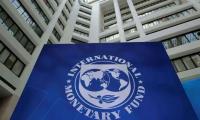WASHINGTON: The global economic crisis will not be quite as grim as feared this year, but GDP will still contract by 4.4 percent and the ongoing pandemic means the outlook remains uncertain, the IMF chief economist Gita Gopinath in Tuesday’s report released ahead of the annual meetings of the IMF and World Bank. In the United States, the economy is now expected to decline 4.3 percent this year, and post growth of 3.9 percent in 2021.
China, where the virus originated, has recovered faster and will see growth of 1.9 percent this year, accelerating to 8.2 percent next year, according to the report. However, Gopinath said that if China is excluded, global growth next year would be negative. While most countries will see their economies return to pre-pandemic levels by 2022, some like those in Latin America will not see a recovery until 2023, she told reporters.
Countries like India, Spain and Italy will suffer double digit economic declines in 2020, while Britain just misses that threshold with a 9.8 percent contraction, the IMF said.
Mehtab Haider adds from Islamabad: The GDP growth rate projection has been lowered to 1 percent of GDP against Pakistan’s official projection of GDP growth rate of 2.1 percent. It was disclosed by the IMF’s World Economic Outlook (WEO) released on the eve of the virtual annual meeting of Breton Wood Institutions (BWIs) of IMF and WB held on Tuesday. However, the IMF projected that Pakistan’s real GDP growth rate to increase to 5 percent by the financial year 2025.
Interestingly, the IMF did not change the revised estimates of GDP growth rate of negative -0.4 percent for the last fiscal year 2019-20. The World Bank had projected negative 1.5 percent GDP growth rate for the last fiscal year 2019-20. Pakistani officials are predicting that the revised GDP growth might worsen because the Large Scale Manufacturing (LSM) data has reflected a bleak picture of the economy in the last couple of months of the previous financial year but they still insisted that the GDP growth might nosedive to the range of about negative 1 percent. They did not expect that the country’s real GDP growth would go down to negative 1.5 percent in accordance with revised estimates for the last financial year.
Both the IMF and WB have projected Pakistan’s GDP growth to range from positive 0.5 to 1 percent respectively. Pakistani authorities are confident that the GDP growth rate might surpass the IMF fixed growth rate because of the base effect as the lower base would push the growth to the higher side. However, the poor performance of agriculture, manufacturing and services sector might negatively affect the overall growth prospects for the current fiscal year.
About the unemployment rate, the IMF has projected it to worsen in Pakistan as the unemployment rate which stood at 4.5 percent in the last fiscal year would further go up to 5.1 percent during the current fiscal year.
The inflation rate will be standing at 8.8 percent for the current fiscal year, which is similar to that of Pakistan’s official estimates showing the CPI based inflation to hovering around 8.8 percent. Though the food prices recently witnessed an upward trend but the projections by IMF and Pakistani officials believe that the overall inflation would remain within the desired range for the current fiscal year. The current account deficit is projected at negative 2.5 percent of GDP for the current fiscal year 2020-21 against negative 1.1 percent of GDP for the last fiscal year.
The IMF’s WEO report states that the remittance flows which contracted sharply during the early lockdown period have shown signs of recovery. Nonetheless, the risk of a decline in payments and transfers from migrant workers back to their home countries is very significant, particularly for such countries as Bangladesh, Egypt, Guatemala, Pakistan, the Philippines, and those in sub-Saharan Africa more broadly.
Awami Muslim League chief appeared in the court with his lawyers Sardar Raziq and Sardar Shehbaz
Board meeting also allowed increase in business center and commercial area of hotel plots from 5 to 10 percent along...
Foreign exchange reserves currently stand at $8 billion, while Pakistan would also receive $1.1 billion IMF tranche:...
CM directed that the enforcement authorities be made functional in six months, and legislation in this regard be...
Pakistani soldiers and policemen stand guard outside the Haripur central jail. — AFP/FileWASHINGTON: The Pakistani...
Establishment Division has also issued an NoC to fill 465 civilian posts in the Ministry of Defence and 11 posts in...







